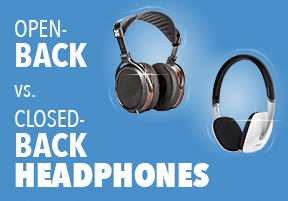- 02.22.2017
- lharper
- MusicTech"knowledge"y
Open-Back vs. Closed-Back Headphones


On the market for a new pair of headphones? If you’ve been looking around, you’ve probably noticed certain headphones being labeled as open-back and others as closed-back. When investing in high quality headphones, it’s important to know what you’re getting so that you can get what’s best for you. Here’s a look at the characteristics that define each type of headphone.
Open-Back Headphones
Open-back headphones are designed to allow some outside noise to mix with the headphones’ output. If you need to remain aware of your external surroundings, this can be a really useful feature. They often generate a more airy and clear sound than their closed counterparts and deliver a more natural sound, similar to that of listening to a pair of speakers. Many also describe them as being slightly more comfortable than closed-back because there is less pressure put on the ear area. The downside of this is that it creates the potential for sound to leak. When using these be conscious of your environment so that you don’t make everyone else listen to your music too.
Closed-Back Headphones
Contrary to the open design headphones, closed-back headphones will isolate you from most external ambient noise. Typically this means that these headphones will have bigger ear-cups and may be slightly heavier. Because of the isolation that these provide, closed-back headphones are often preferred by those in music production as well as in other areas where critical listening is needed. For those who want to be able to zone out or who regularly use public transportation, these are also a great option.
What’s best for you?
Both headphone designs have their benefits and drawbacks, what is best for you depends on what you want your experience to be like and what environment you’ll be listening in. Open-backs are lighter and provide a more natural sound, but they allow some ambient sounds through and the sound leak can inconvenience those around you. Closed-backs are somewhat heavier, but provide better sound isolation. If you have any questions about which design is a better investment for you, don’t hesitate to visit or call one of our locations and let us walk you through everything you need to know.
